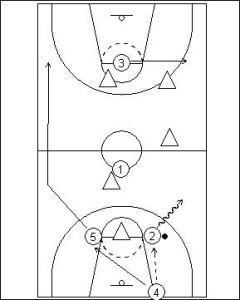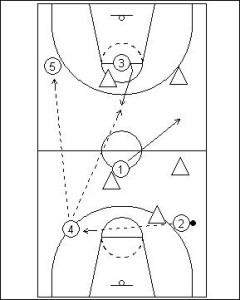Press Breaker: Forward Bump
A Press Breaker is a type of transition specially designed to overcome the extended trapping defences. The Press Breaker Forward Bump Play looks to change the sideline down which the ball is passed while using the team’s forwards to help progress the ball. This means the quicker, often more agile players in the full court and best ball handlers are left to fill spaces that are the highest-pressure areas.
This press breaker can help against a number of different formations. Standard full court formations such as 1-2-1-1, 1-2-2 or 2-2-1 are all possible trapping situations that the Forward Bump Play will work against.
As a point of note it is important to attack the basket once the ball is progressed to the three-point line. This will assist in pushing the defence out of their extended pressure. Even if the Press Breaker Forward Bump Play works in avoiding a turn-over situation as a result of the trapping defence, unless the offense looks to make this into an early scoring option the defence will see no reason to change-up or move away from the tactic.

The Press Breaker Forward Bump Play starts with players moving into positions up the floor. Both Bigs (Four and Five) remain in the backcourt. This is a unique situation but is important in extending the defence and forcing them to guard the more potent offensive players against a full court press (such as One, Two and Three).
The formation is 1-2-1-1. Four (4) is the inbounder, Five (5) and Two (2) are the initial outlet targets. One (1) moves towards halfway and Three (3) sprints in the full court to the frontcourt foul line.
The target for the outlet is Two (2). Both Two (2) and Five (5) should create a lead for the ball. If pressure is tight on Two (2) then Five (5) can be used as a screener to help free the player from their defensive pressure.
Once the ball is inbounded Two (2) looks to take two hard and quick dribbles towards halfway and sideline. This will force the defensive players to rotate and once these players are rotating, there will be a greater opportunity for passing.
Three (3) looks to head towards the same sideline as Two (2). This will pull the defence across the floor opening up the weak side for attack.
After making the inbound pass Four (4) moves onto the floor to secure a good passing lane from Two (2).
This action triggers the “bump” between four (4) and Five (5). Once Four (4) replaces Five’s (5) starting position, then Five (5) will look to sprint the sideline and will not stop until they have reached the three-point line in the frontcourt.
If Five (5) is free of defensive pressure then a pass across court maybe a suitable option if made prior to Five (5) breaking the halfway line.

Two (2) will finish in a jump stop so that the player has the option of pivoting on either foot. Two (2) will look reverse the ball to Four (4).
Four (4) then has a number of options to pass to:
- Five (5) down the sideline off a long pass
- Three (3) on the lift up the split line
- One (1) id defence reacts early and tries to deny pass to Five (5) and Three (3)
If the pass is made to Five (5), Three (3) will need to dive to the basket and become a post target early on in the offense.
The Press Breaker Forward Bump Play looks to provide space for the best suited players (One, Two and Three) against a full court press to make reads and move into space. This should make the offense harder to defend and provide better offensive output.








Leave a Reply